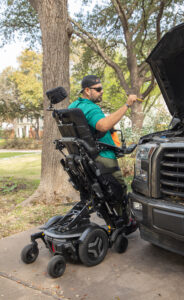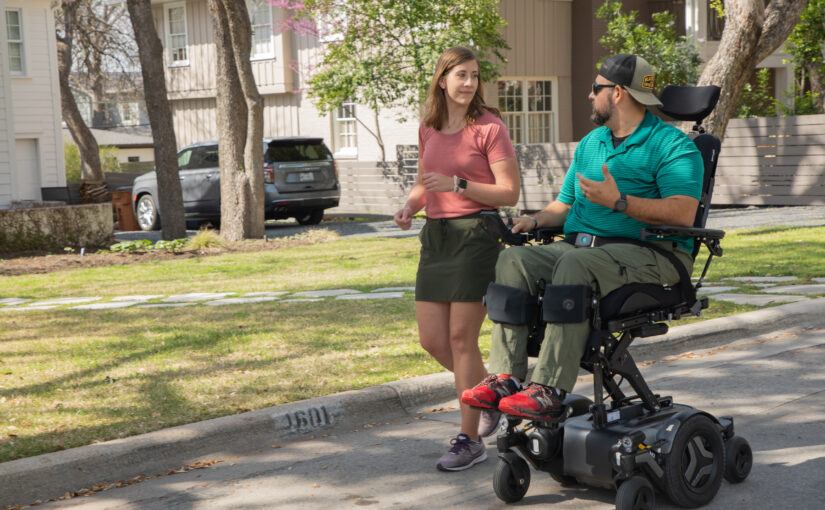Photos provided by Permobil
Advances in complex rehab technology continue to redefine accessibility and independence for injured workers. And manufacturers continue to refine their offerings.
ATF Medical stays up to date on the latest, always monitoring new products, features and benefits so we can recommend the best fit for an injured worker. Our Manager of Complex Rehab David Bedard, ATP, C.H.A.M.P. recently checked out Permobil’s new M Corpus VS Power Chair and shared some thoughts.
This remarkable chair combines the maneuverability of mid-wheel drive with an anterior tilt feature, delivering new accessibility and functionality for injured workers.
“A lot of standing chairs have front-wheel drive and can’t turn in tight spaces,” Bedard said. “This new model features a mid-wheel drive, which cuts down on the chair’s footprint when turning.”
Even more innovative is its anterior tilt feature, which enables the seating system to move into a 45-degree anterior tilt. Typically, power wheelchairs come with a posterior tilt function.
“The forward tilt is fairly new,” Bedard explained. “Permobil calls this ActiveReachTM because it allows patients to tilt forward and reach in front of themselves. “This way they can do more activities of daily living, help their kids get ready for school, or use a keyboard. This feature will enable some people to return to work.”
In previous blogs and Linked In posts, we have discussed the many ways standing chairs increase functionality and accessibility. Using one, an injured worker can stand at a stove of standard height, cook their own meals and reach for something from a top shelf.
 Healthwise, the standing position empowers the body to work as designed. Standing is good for circulation, bone density, muscle strength, and it helps reduce atrophy. Standing chairs also improve bladder and bowel management because they put people in position to allow gravity to void fluids from the body. This helps prevent urinary tract infections (UTIs). In addition, standing chairs provide one of the best pressure release techniques, helping patients avoid painful pressure injuries (wounds.)
Healthwise, the standing position empowers the body to work as designed. Standing is good for circulation, bone density, muscle strength, and it helps reduce atrophy. Standing chairs also improve bladder and bowel management because they put people in position to allow gravity to void fluids from the body. This helps prevent urinary tract infections (UTIs). In addition, standing chairs provide one of the best pressure release techniques, helping patients avoid painful pressure injuries (wounds.)
“In fact, standing chairs help people live longer and healthier,” Bedard said.
They also provide all kinds of mental health benefits. Being more productive, being able to look people in the eyes during conversations, and being able to work again are huge. Standing chairs make it easier for injured workers to get out into the world and interact with people. They can stand at a counter to pay for something and more easily reach items on grocery store shelves. or at work and engage with friends. In short, they facilitate confidence and independence.
ATF Medical analyzes the complex rehab technology and adaptive housing options when recommending and developing a cost-effective solution for an injured worker. Standing chairs, for example, can avoid the need for extensive home modifications. There’s no need to lower kitchen cabinets, build pull-out drawers, and install special stoves and other appliances. The new M Corpus VS with its smaller turning radius opens access to tight spaces without major remodels and increases functionality.
ATF Medical focuses on the person’s condition and likely progress when developing a solution for an injured worker. This chair won’t work for everyone, but it will literally change the lives of some.
Why don’t you review your book of claims and let us help you decide which injured workers would benefit from these new features? If you have questions or just want to know more, please contact David Bedard at dbedard@atfmedical.com.

